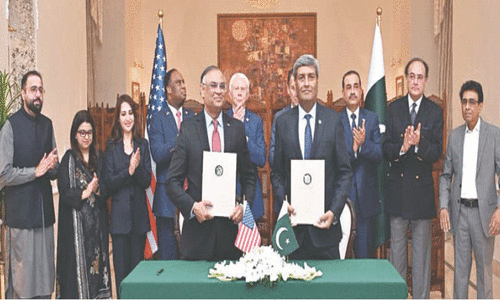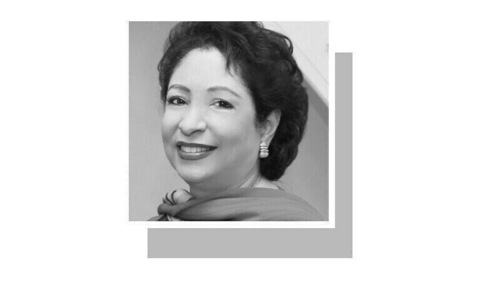 RAWALPINDI, Feb 15: It is a battle of political survival and revival in Rawalpindi and Monday’s election will decide who captures what in the city that can lay claim to be the country’s conspiracy capital.
RAWALPINDI, Feb 15: It is a battle of political survival and revival in Rawalpindi and Monday’s election will decide who captures what in the city that can lay claim to be the country’s conspiracy capital.
A key former federal minister and a similarly important former Punjab minister seem to be struggling against the opposition candidates in the Feb 18 polls as does their till recently ruling Pakistan Muslim League (PML) nationally.
Things have never been so challenging for former federal information and railways minister Sheikh Rashid Ahmed after winning six times there as both Pakistan People’s Party (PPP) and Pakistan Muslim League-Nawaz (PML-N) are out to grab once again what had been one of their strongest bastions in the Punjab province in different decades.
The Sheikh is contesting for both Rawalpindi city seats he had won in 2002 as an independent and is facing strong challengers in PML-N central figure Makhdoom Javed Hashmi and PPP activist and lawyer Malik Aamer Fida Piracha in NA-55, and PPP lawyer Sardar Shaukat Hayat Khan and PML-N’s fresh convert from MMA and former MNA Mohammad Hanif Abbasi in NA-56.
Former Punjab law minister Mohammad Basharat Raja, who has been a close associate of the famous Chauhrys of Gujrat in recent years, is this time challenging PPP’s 2002 victor and legal activist Zamurd Khan and PML-N’s Malik Abrar Ahmad in NA-54 of Rawalpindi Cantonment, although the PML candidate had lost a provincial assembly seat in his same native constituency and the Chaudhrys had to get him elected from one in Gujrat in a by- election so he could become a Punjab minister.
 While the PML popularity graph seems to be at its lowest these days, mainly because of people’s hardships due to food shortages and energy cuts, both PPP — additionally helped by a sympathy wave after Benazir Bhutto’s assassination — and PML-N see a chance to revive the political hold they had over Rawalpindi in the 1970s and the 1990s respectively.
While the PML popularity graph seems to be at its lowest these days, mainly because of people’s hardships due to food shortages and energy cuts, both PPP — additionally helped by a sympathy wave after Benazir Bhutto’s assassination — and PML-N see a chance to revive the political hold they had over Rawalpindi in the 1970s and the 1990s respectively.
A similar position can be reflected in the contests for provincial assembly seats although no big figure of any of the three main parties is involved.
But PML candidates are putting up a brave face against these odds, apparently pinning their main hopes on what the PML- controlled nazims and the PML-led interim government can do for them in what opposition parties call vote-rigging as well as the credit for development work during the five-year government of their party, which seems to have been largely washed away by the latest hardships of the population.
PPP seems laying more claim to benefit from the present situation as it was outside Rawalpindi’s Liaquat Bagh park that their leader Benazir Bhutto was killed in a gun-and-bomb attack on Dec 27 after she had addressed an election rally there, in what came to be latest of the major political conspiracies which were either hatched or carried out in Rawalpindi since early 1950s.
Most of these happenings, including failed and successful attempts to topple governments, the murder of Pakistan’s first prime minister at the same venue of Liaquat Bagh and the execution of a toppled prime minister in a Rawalpindi jail not very far from there, are discussed and solutions are proposed during the campaign, which finds the opposition parties in dominant postures in a city which continues to be the home of President Pervez Musharraf even after he gave up as chief of the army staff in November.
Although the so-called Rawalpindi Conspiracy of February- March 1951 was unearthed before being implemented, Prime Minister Liaquat Ali Khan was shot dead with a pistol just as he rose to address a public rally at the park later named after him.
Though Karachi was then the political capital, Rawalpindi’s role was obvious in political manipulations that led to Pakistan’s first nationwide martial law in October 7, 1958 with then army commander-in-chief General Mohammad Ayub Khan becoming the chief martial law administrator, removing President Iskandar Mirza 20 days later and then ruling for the next 10 yeas.
Other major events, often called compulsions by those who staged them and conspiracies by their critics, included General Yahya Khan’s takeover from a politically besieged Ayub Khan in 1969, his military operation in then East Pakistan two years later that led to the creation of Bangladesh, General Ziaul Haq’s toppling of prime minister Zulfikar Ali Bhutto in 1977 and hanging him in 1979 after a controversial trial, the general- president’s dismissal of his own hand-picked prime minister Mohammad Khan Junejo in 1988 months before being killed in a mysterious plane crash, alleged bribes given to political parties to check the rise of Benazir Bhutto, presidential sackings of Ms Bhutto as prime minister twice of Nawaz Sharif once and then the last army coup in which General Musharraf toppled Nawaz Sharif in Oct 1999.
What has now happened to the country’s superior judiciary also started with a meeting deposed Chief Justice Iftikhar Mohammad Chaudhry had with President Musharraf in Rawalpindi.
No other Pakistani city can lay claim to such a dubious distinction, to which the people of Rawalpindi have little contribution, though the role of their residents is prominent in Islamabad as Pakistan’s political capital, Lahore as the cultural capital and Karachi as the commercial capital.
As elsewhere, the PML’s association with the Musharraf presidency adds to its woes, even in Rawalpindi, none of the party candidate daring to have the general’s picture on their posters and banners, contrary to Zulfikar Ali Bhutto and Benazir Bhutto looming large on PPP posters and Nawaz Sharif on PML-N posters along with their candidates and elections symbols of Arrow and Tiger respectively.
During a drive through Rawalpindi on Friday, even taxi cabs and taxi vans plying in the city were seen happily flying the PPP and PML-N flags, though Basharat Raja’s posters dominated his ancestral Dhamial area of Rawalpindi Cantonment.
|
Party Positions And Vote Percentage 2002 |
|||
|
Constituency |
Political party |
Position |
Vote% |
| NA-50 | PPP |
1 |
43.31% |
| PML-N |
2 |
37.21% |
|
| NA-51 | PPP |
1 |
45.63% |
| PML-Q |
2 |
25.89% |
|
| NA-52 | PML-N |
1 |
49.11% |
| PML-Q |
2 |
37.76% |
|
| NA-53 | Ind |
1 |
42.19% |
| PML-N |
2 |
36.01% |
|
| NA-54 | PPP |
1 |
37.59% |
| PML-N |
2 |
33.38% |
|
| NA-55 | IND |
1 |
48.70% |
| PPP |
2 |
34.60% |
|
| NA56 | IND |
1 |
48.27% |
| PPP |
2 |
31.02% |
|
|
Registered Voters And Turnout In 2002 |
|||
| Constituency | Turnout | Registered Voters | |
| NA-50 |
47.78% |
0.358 million |
|
| NA-51 |
51.87% |
0.345 million |
|
| NA-52 |
48.89% |
0.306 million |
|
| NA-53 |
50.98% |
0.291 million |
|
| NA-54 |
39.97% |
0.209 million |
|
| NA-55 |
38.77% |
0.254 million |
|
|
Rawalpindi District Profile |
|||
| Population: | 4.41m (estimated for 2008) | ||
| Population Density: | 637 person per sq.km | ||
| Major clans: | Bhatti, Rawal, Janjua, Chohan, | ||
| Awan, Mughal, Qureshi, Syed, Abbasi and Satti | |||
| Literacy Rate: | Urban: 76.01% Rural: 63.94% | ||
| Housing: | Kaccha and Semi Pucca: 6.67% | ||
| Utilities: | Water: 68% Electricity: 91% | ||
| Employment | Agriculture: 36.9% | ||
| Elementary Occupation: 21.5% | |||
|
Current Race |
|||
| Constituency | Contestants | Party Affiliation | |
| NA-50 | Shahid Khaqan Abbasi | PML-N | |
| Ghulam Murtaza Satti | PPP | ||
| Javed Satti | PML-Q | ||
| NA-51 | Chaudhry Riaz | PML-N | |
| Raja Qasim Javed | PML-Q | ||
| Raja Pervez Ashraf | PPP | ||
| NA-52 | Nasir Raja | PML-Q | |
| Khurram Pervez Raja | PPP | ||
| Chaudhry Nisar Ali Khan | PML-N | ||
| NA-53 | Ghulam Sarwar Khan | PML-Q | |
| Sardar Shoaib Mumtaz | PPP | ||
| Chaudhry Nisar Ali Khan | PML-N | ||
| NA-54 | Zamarrud Khan | PPP | |
| Malik Abrar | PML-N | ||
| Basharat Raja | PML-Q | ||
| NA-55 | Javed Hashmi | PML-N | |
| Sheikh Rashid Ahmed | PML-Q | ||
| Amir Fida Paracha | PPP | ||
| NA56 | Hanif Abbasi | PML-N | |
| Sardar Shaukat Hayat | PPP | ||
| Sheikh Rashid Ahmed | PML-Q | ||














































